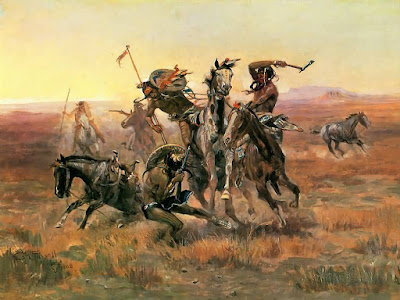 |
| Charles Russell - When Blackfoot and Sioux Meet |
Education of Native Americans began
early in Indian-White contact. Missionaries of all denominations ventured into
the frontier to “civilize” the Indian. Among the first to campaign for
“civilizing” Native Americans was John Daniel Hammerer, an Englishman. In the
1730s, he published Account of a Plan for
Civilizing the North American Indian he expressed his view of the “Indian
Problem”:
Promote their spiritual
as well as temporal welfare, as far it is the Power of Men, and therefore,
might be concluded to be of their duty to do it; so, on the other hand, a
gradual stop would thereby be put to those bloody wars, and horrid barbarities
. . . and a great expense of men and money saved to this Nation. (John D.
Hammerer, Account of a Plan for
Civilizing the North American Indians, 1, Historical Printing Club1890)
Not until one hundred and fifty
years later, in the 1870s, did the federal government institutionalize his
ideas by making education compulsory for all Native Americans. At the forefront
of this federal educational agenda Richard Henry Pratt opened the first
off-reservation boarding school. Pratt
tested his experimental educational system on 72 prisoners from the Kowa,
Comanche, and Chyenne tribes. The government turned the prisoners over to Pratt
after being captured in the Red River War. In 1875, Pratt transported these men
from the plains to Fort Marion, a small abandoned fort in Florida. (Wilcomb E. Washburn,
“History of Indian-White Relations” Handbook
of North American Indians, 290, 1988)
The boarding school system, which
based itself on forced assimilation and isolation of Native American children,
spread throughout the West. The number of off-reservation boarding schools
increased from only the Carlisle School (under the direction of Richard Pratt)
in the Hampton Institute, in the early 1870s, to 25 schools in 1900. (Szasz
1974:10) In the 1880s, schools originally under the direction of religious
denominations were placed under federal direction. By the 1920s and 1930s,
federal boarding schools were less common and funding was redirected to
reservation-based day schools, which were obtaining a larger attendance.
On the Flathead reservation,
Russell Tharp attended a reservation school similar to the type previously
mentioned with a deeply imbedded assimilation agenda. The most powerful aspect
of the federal educational system was the ban on speaking native languages in
the school classroom. With the English-only educational system, young Native
Americans lost much of their oral history. Russell adapted easily into the
Eurocentric schooling system by taking part in athletics, specifically
baseball, basketball and track.
For high school, Russell Tharp
moved to 340 South Third Street, Missoula, Montana. There, he enrolled into
Cramer Addition, a local high school. After graduation Dartmouth College of New
Hampshire offered to give him a scholarship in pole-vaulting. Russell declined
the offer and entered into the University of Montana in Missoula.
During Russell Tharp’s teenage
years, Senator Burton K. Wheeler of Montana was drafting ground braking
legislation in Native American policy. The Howard-Wheeler or Reorganization
Act, as it would be called, helped consolidate reservations divided by the
allotment policy of the Dawes Act. This legislation was the first attempt by
the federal government to give Native Americans a voice. Disappointingly, the
federal policy resulting from this act created a more paternalistic atmosphere
on reservations.
The Johnson-O’Malley Act, passed in
1934, also brought change in the Native American community. This federal
legislation “authorized federal support for Indian clients utilizing
majority-run education, health, and social service agencies and facilities.” (Laurence
French, Psychocultural Change and the
American Indian, 35, Garland Publishing 1987) Therefore, under this
legislation, the school system faced major reform and restructuring. The
reformation of the government schooling system ended an era of forced
assimilation and cultural genocide supported and controlled by the federal
government. Articulate and verbose reformers pushed the federal government into
an era of cultural suppression and in the same manner saved the United States
from destroying part of its identity, Native North American cultures.
 |
| Charles Russell's view on the plight of Indians |
Despite the revolutionary aspects
of this reform, it did not immediately affect Russell and other Native
Americans of Montana. On one hand, the educational system still enforced the
assimilationist agenda and on the other the Great Depression brought hard times
to Montana. As a result of these social influences, Russell Tharp moved out of
Montana. Russell’s daughter Nancy Josephine Clark put it poignantly, “They
(Native Americans) wanted to get out of Montana . . . No one could be proud to
be an Indian.” After Russell’s second year at the University of Montana, he
left his native roots in Montana and moved to Spokane, Washington to attend
business school.
Written by Dr. Clancy J. Clark




No comments:
Post a Comment